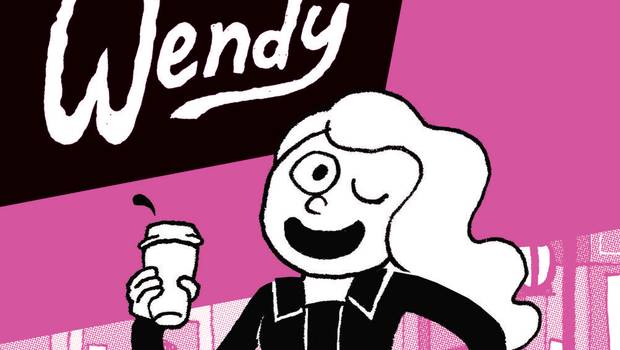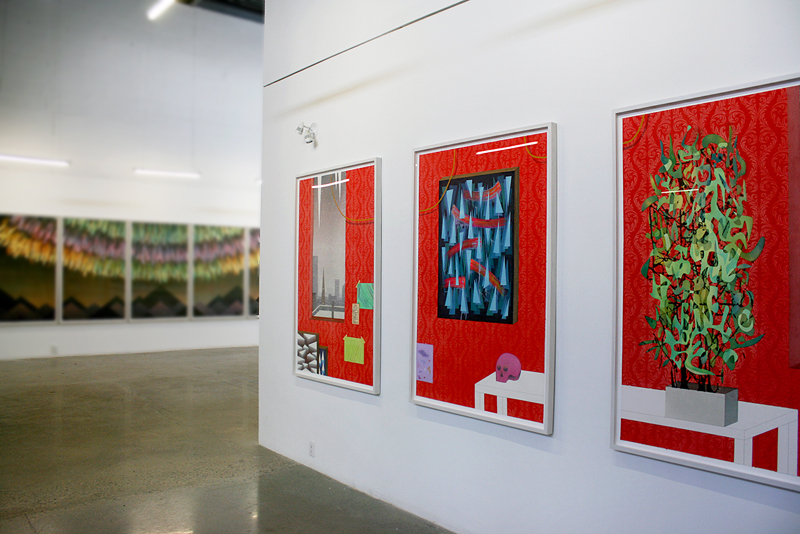Walter Scott, Roxane Gay, and Wendy
Wendy is the brainchild of artist Walter Scott. She’s young, blonde, fresh out of art school and lives in an unnamed city that is a lot like Montreal. She works in a coffee shop (sort of) and spends her nights at indie music shows, getting high, and obsessing over boys who play in bands. She’s trying to get a toehold in the art world, but she can’t seem to keep it together long enough to finish an artist proposal.
Released in late 2014, Wendy is a full-length comic that follows Scott’s youthful and foolish protagonist as she navigates the volatile terrain of late adolescence in the (presumably) Canadian art world. It’s a familiar landscape, and one that Scott understands with astounding clarity.
 We witness Wendy’s bizarre friendships and rivalries with the figures of Vienna and Paloma, two women who fluctuate between being revered as art world idols and derided as cruel nemeses. Wendy explores everything from the unspoken hierarchies that define creative communities to the thrilling social and sexual flirtations that take place across all strata of this neatly defined system. Scott playfully mocks the convoluted language tied to certain artistic practices, and deftly captures the general squalor that comes with being a young artist. If nothing else, Wendy’s hysterical typology of the artists at the FloJo (read: Banff) residency is sure to amuse anyone who survived an education in fine arts, new media, or curatorial studies.
We witness Wendy’s bizarre friendships and rivalries with the figures of Vienna and Paloma, two women who fluctuate between being revered as art world idols and derided as cruel nemeses. Wendy explores everything from the unspoken hierarchies that define creative communities to the thrilling social and sexual flirtations that take place across all strata of this neatly defined system. Scott playfully mocks the convoluted language tied to certain artistic practices, and deftly captures the general squalor that comes with being a young artist. If nothing else, Wendy’s hysterical typology of the artists at the FloJo (read: Banff) residency is sure to amuse anyone who survived an education in fine arts, new media, or curatorial studies.
For all its biting comedic insight, Wendy left me cold, angry even. The women in the wendiverse prey on eachother and get caught up in petty jealousies over superficial relationships with men. Wendy consistently makes ill-advised choices including falling for a sleazy, drugged-up, and vaguely radical band boy, and then pursuing him at the expense of alienating her friends. She all too easily loses sight of her ambition to hone her artistic practice to the point of legitimacy. Couldn’t she just pull it together, get a halfway decent job and focus on securing an exhibition assistance grant? I mean, what is her deal?
I wanted so badly for Wendy to be a quirky and upright role model for young women in the art world, I wanted her to succeed, to see through the people who were using her, and to make smart choices (whatever that means). As it turns out, I was so caught up in my own anxieties about representations of young women in the art world that I may have missed the point.
When I put down Wendy, I picked up Roxane Gay’s Bad Feminist in search of some of Gay’s trademark wisdom to put me at ease. In one of her many ruminations on fiction, Gay calls out the tendency to attribute character flaws in fictional girls and women to larger conditions such as alcoholism or mental illness. She notes that the need to pathologize imperfections is a special prejudice reserved for female characters who -unlike their male counterparts – cannot simply be complex or imperfect. When a woman displays bad judgment in fiction, there must be something wrong with her. But when Raskolnikov throws an axe in the face of an innocent woman (spoilers!) he is a tormented philosopher at the pinnacle of metaphysical angst. Gay writes: “If people cannot be flawed in fiction there’s no place left for us to be human.” Well, damn.
I don’t know why I was so hard on Wendy at first. What I do know is that I am ready to celebrate her as an honest, real, great big fu#{b29860ee6b7af5bf99d3058cca3182816eed414b47dab251265e93b8c00e69b1}&ing mess of a person. At least, I’m ready to try.
SOURCE: Art Bitch - Read entire story here.
Read More




